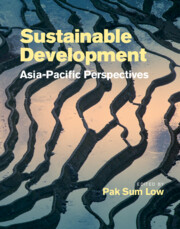Book contents
- Sustainable Development: Asia-Pacific Perspectives
- Sustainable Development: Asia-Pacific Perspectives
- Copyright page
- Dedication
- Contents
- Notes on contributors
- Peer reviewers
- Editor’s note
- Foreword
- Foreword
- Foreword
- Foreword
- Foreword
- Environmental keystones: Remembering Dr Mostafa Kamal Tolba
- Remembering Dr Mostafa Kamal Tolba
- Remembering Dr Mostafa Kamal Tolba
- Acronyms and abbreviations
- SI prefixes
- Unit abbreviations
- Chemical formulae
- Part I Sustainable Development: Theories and Practices
- Part II Sustainable Development: Challenges and Opportunities
- 17 Scientific responses in an era of global change
- 18 Government communication on transboundary haze: The nexus between public health and tourism
- 19 Biomass energy prospects: A promising fuel for sustainable development in Asia and the Pacific
- 20 Pathways to a more sustainable electricity sector in India
- 21 Gender equality and energy access: Barriers to maximizing development effectiveness in the SAARC region
- 22 The biosphere and the interactions between stratospheric ozone depletion and climate change
- 23 The political challenge of linking climate change and sustainable development policies: Risks and prospects
- 24 Social vulnerability to climate change in Cambodia, Lao PDR, and Vietnam
- 25 Sustainable development in Bangladesh: Bridging the SDGs and climate action
- 26 Sustainable development in Pakistan: Vulnerabilities and opportunities
- 27 Beyond protected areas: Biodiversity conservation and global change in Asia and the Pacific
- 28 Causes of land-use change and biodiversity loss in Monsoon Asia
- 29 Assessing linkages between land use and biodiversity: A case study from the Eastern Himalayas using low-cost, high-return survey technology
- 30 Where to invade next: Inaction on biological invasions threatens sustainability in a small island developing state of the tropical South Pacific
- 31 Did the Indian Ocean tsunami trigger a shift towards disaster risk reduction?
- 32 Cyclone Nargis and disaster risk management in Myanmar
- Index
- Endmatter
- References
27 - Beyond protected areas: Biodiversity conservation and global change in Asia and the Pacific
from Part II - Sustainable Development: Challenges and Opportunities
Published online by Cambridge University Press: 23 December 2021
- Sustainable Development: Asia-Pacific Perspectives
- Sustainable Development: Asia-Pacific Perspectives
- Copyright page
- Dedication
- Contents
- Notes on contributors
- Peer reviewers
- Editor’s note
- Foreword
- Foreword
- Foreword
- Foreword
- Foreword
- Environmental keystones: Remembering Dr Mostafa Kamal Tolba
- Remembering Dr Mostafa Kamal Tolba
- Remembering Dr Mostafa Kamal Tolba
- Acronyms and abbreviations
- SI prefixes
- Unit abbreviations
- Chemical formulae
- Part I Sustainable Development: Theories and Practices
- Part II Sustainable Development: Challenges and Opportunities
- 17 Scientific responses in an era of global change
- 18 Government communication on transboundary haze: The nexus between public health and tourism
- 19 Biomass energy prospects: A promising fuel for sustainable development in Asia and the Pacific
- 20 Pathways to a more sustainable electricity sector in India
- 21 Gender equality and energy access: Barriers to maximizing development effectiveness in the SAARC region
- 22 The biosphere and the interactions between stratospheric ozone depletion and climate change
- 23 The political challenge of linking climate change and sustainable development policies: Risks and prospects
- 24 Social vulnerability to climate change in Cambodia, Lao PDR, and Vietnam
- 25 Sustainable development in Bangladesh: Bridging the SDGs and climate action
- 26 Sustainable development in Pakistan: Vulnerabilities and opportunities
- 27 Beyond protected areas: Biodiversity conservation and global change in Asia and the Pacific
- 28 Causes of land-use change and biodiversity loss in Monsoon Asia
- 29 Assessing linkages between land use and biodiversity: A case study from the Eastern Himalayas using low-cost, high-return survey technology
- 30 Where to invade next: Inaction on biological invasions threatens sustainability in a small island developing state of the tropical South Pacific
- 31 Did the Indian Ocean tsunami trigger a shift towards disaster risk reduction?
- 32 Cyclone Nargis and disaster risk management in Myanmar
- Index
- Endmatter
- References
Summary
Protected areas have been the cornerstones of biodiversity conservation in the recent past. Many of them are under threat from local pressures, such as resource extraction and habitat encroachment. In addition, conservation managers are increasingly faced with global change and its drivers. These include climate change, globalization of trade and investment patterns, violent conflict, and migration, as well as HIV/AIDS and other pandemics. This chapter will explore a couple of these drivers of change in the Asia-Pacific context and assess their respective impacts on ecosystems and biodiversity. It will highlight the importance of adopting perspectives over a longer time and at larger spatial scales, and the need to look beyond the boundaries of conservation areas to address these challenges.
Keywords
- Type
- Chapter
- Information
- Sustainable Development: Asia-Pacific Perspectives , pp. 359 - 366Publisher: Cambridge University PressPrint publication year: 2022



